A Soulful Journey Through the Streets of Old Québec
If cities could whisper, Québec City would tell stories in French. It would murmur tales of explorers and missionaries, of market women and mapmakers, of winter carnivals and summer light. It would wrap you in warmth even as the wind from the St. Lawrence River rolls cold off the water. And so we walked — not just through a city, but through centuries.

🏞️ 1. Plains of Abraham – Fields of Memory
At sunrise, mist rolled gently over the Plains of Abraham, where green fields once echoed with cannon fire. The Plains of Abraham Museum told the tale with maps, soundscapes, and relics — a story of empire, sacrifice, and destiny carved into the very earth beneath my feet.
🏰 2. La Citadelle – Fortress in the Sky
A stone’s throw uphill led me to La Citadelle, the great star-shaped fortress perched atop Cap Diamant in Québec City. This impressive fortification is not only a marvel of military architecture but also one of Canada’s oldest active military installations, serving as a base for the Royal 22nd Regiment (the “Van Doos”) and an official residence for the Governor General of Canada.
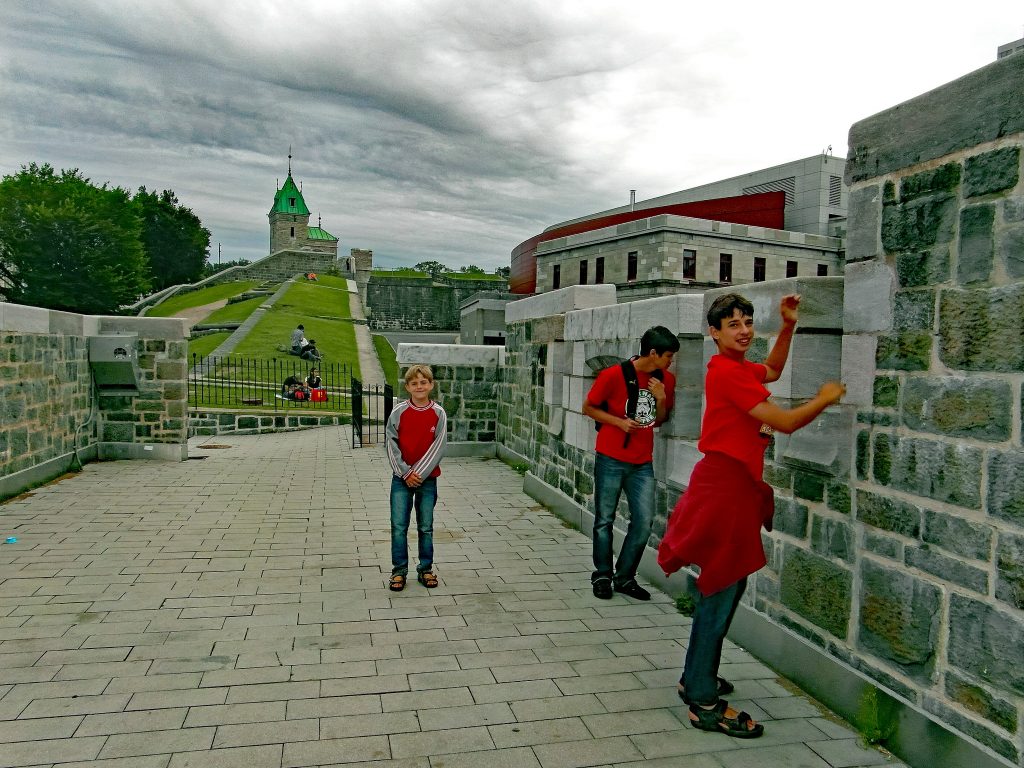
Historical Background
La Citadelle was constructed between 1820 and 1832 by the British, in response to increasing tensions with the United States after the War of 1812. Strategically located on Québec’s highest point, it provided a strong defense position to guard against any potential American invasion via the St. Lawrence River. The fortress, with its imposing walls and star-shaped layout, was designed following the principles of Vauban, a famous French military engineer known for his star forts.
The site itself has a military history dating back to the French colonial era. Under the command of Governor Frontenac in the late 17th century, initial fortifications were established to protect the colony. The Citadelle we see today, however, is largely a British creation and stands as a reminder of the colonial struggles and strategic significance of Québec.
🏛️ 3. Hôtel du Parlement – The Voice of a Nation
Not far beyond, the Parliament Building stood regal in its gardens. The statues of Champlain, Cartier, and more looked on as fountains sparkled near the Fontaine de Tourny. The words “Je me souviens” seemed etched into the very air.
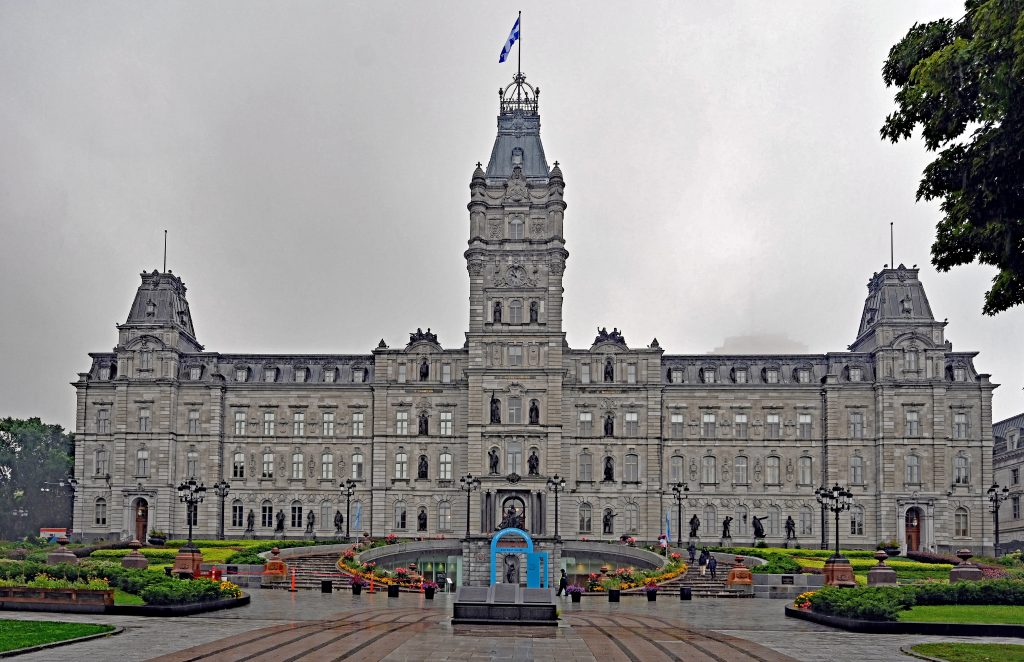
The Building was erected between 1877 and 1886. It is an imposing structure whose four wings form a large square. Its architecture, inspired by the Louvre Palace in Paris, makes it one of the only French-style institutional buildings in Québec City. It is Québec’s oldest historic site and the seat of Québec’s government. The building’s main facade boasts 26 bronze statues erected to the memory of key historical figures. It’s a fascinating place full of secrets and surprises.
You can take a free guided tour of the Parliament, where the national assembly’s
125 members determine the fate of the province. The tour lasts 75 minutes and delves into the history and workings of Québec’s parliamentary institutions as well as the history of the province itself. Cap off the experience with a meal at Le Parlementaire, a swank restaurant that serves up delicious local products. It’s one of the hill’s best‑kept secrets!
🛍️ 4. Rue Saint-Jean – The City’s Vibrant Vein
From politics to poetry, I stepped onto Rue Saint-Jean, alive with street performers, colorful façades, and tempting boutiques. Boulangeries spilled scents of croissants and espresso into the street. I browsed shelves of Québec literature, hand-knitted scarves, and local artworks — and couldn’t resist the sweet pull of maple fudge at a nearby confiserie.
Rue Saint-Jean is one of Québec City’s oldest commercial stretches. In the 19th century, merchants settled there in droves in houses that doubled as their place of business, lending the street its special charm.
Surveyor Jean Bourdon laid out and named rue Saint-Jean, the route he took to get to the centre of town from his Saint-Jean fief in 1650 or thereabouts.

5. Pub St. Patrick – Irish Warmth, Québec Heart
Amid the swirl of Rue Saint-Jean stood the legendary Pub St. Patrick, housed in a building from the 1800s with stout stone walls and stained glass. Inside, Irish heritage met Québec pride with wooden beams, Gaelic songs, and a crackling hearth. Over a pint of local ale and a shepherd’s pie, I rested and listened — to laughter, music, and the soft buzz of conversation echoing from the past.
🕍 6. Rue de Buade – Where Time Lingers
Just steps away, Rue de Buade offered a quieter rhythm. Lined with historic buildings and crowned by the majestic Notre-Dame de Québec Basilica-Cathedral, it whispered of processions and pilgrims. I traced my fingers across ancient stone as the bells chimed noon above the cobblestones.
⛪ 7. Notre-Dame de Québec
Notre-Dame-de-Québec has served the first Catholic parish in North America ever since 1664. It acquired cathedral status in 1674 when it became the seat of the huge Diocese of Québec, and 200 years later, that of a basilica. Its history has been marked by shelling, fires, and multiple reconstructions and renovations. Phoenix-like, it has risen from its ashes and continues to soar.
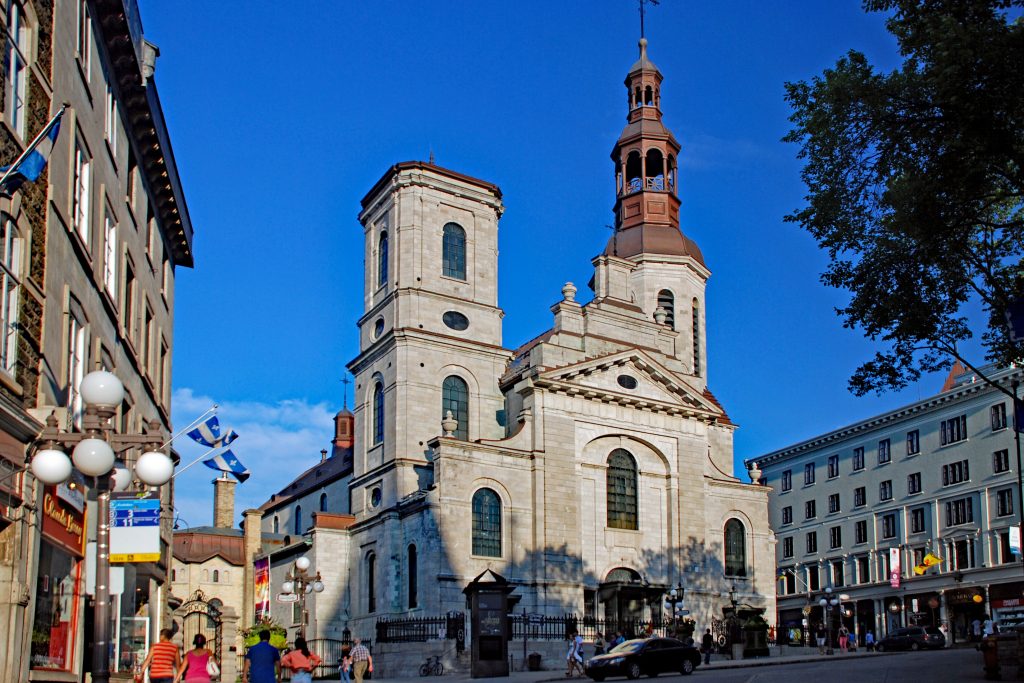
The cathedral-basilica was built on the site of the first chapel constructed by Samuel de Champlain in 1633. After the first building burned down, the Jesuits built another church in 1647, this time in stone. The oldest components of the cathedral-basilica date back to this period.
Inside the cathedral, light poured through kaleidoscopic glass onto the gold-leaf altar. I paused at the Holy Door, reflecting on the symbolism of passage and peace. Next door, the Rectory stood with
timeless grace, and the Shop Our Lady of Québec offered delicate keepsakes and blessings to take home.
📮 8. Dufferin Terrace – The Balcony of Dreams
The Dufferin Terrasse was alive with music, artists, and the scent of roasted chestnuts. I wandered its long wooden walk, pausing for views of the icy blue St. Lawrence River and the cliffs of Lévis. Beneath the promenade lay the ruins of Château Saint-Louis, now a preserved archaeological site, echoing with centuries of command.
👑 9 Château Frontenac – Queen of the Skyline
Towering above the terrace, the Château Frontenac stood proud and fairytale-like — green-roofed, turreted, and timeless. Inside, marble floors and golden chandeliers shimmered like a film set. Outside, its towering frame cast long shadows across the boardwalk. I could almost see dignitaries and dreamers from centuries past stepping from its grand entrance.

When Canadian Pacific Railway executives broke ground on the Château Frontenac in 1892, their objective was to give Québec City a prestigious hotel for tourists. This new type of well-off traveller circled the globe in search of picturesque new sights. Québec City was among Canada’s most popular destinations. With the port welcoming cruise ships from Europe and the United States, and the city served by train, it was the
perfect location for the most ambitious hotel in the chain the company established along its pan-Canadian network.
🎨 10. Musée du Fort & Rue du Trésor
Across the square, the Musée du Fort lit up history with a dramatic sound-and-light retelling of Québec’s most famous sieges. Just beyond, the Rue du Trésor awaited — an outdoor art gallery filled with the color and soul of local artists, each canvas a love letter to the city’s seasons, skyline, and stories.
🌳 11. Hôtel de Ville & Monument Cardinal Taschereau
I arrived at the City Hall, framed by floral gardens and fountains. The Monument to Cardinal Taschereau, noble and serene, watched over passersby from his leafy square. From politics to faith, this was a city built on conviction.
🎭 12. Fresque des Québécois & Côte de la Montagne
Down a quiet side street, the Fresque des Québécois came into view — an immense trompe-l’œil mural that felt alive. Historical figures, artists, and everyday citizens were painted so vividly they almost stepped off the wall. I followed the winding Côte de la Montagne downward, past centuries-old stone buildings, toward the heart of the old port.
🪜 13. Breakneck Steps & Rue du Petit-Champlain
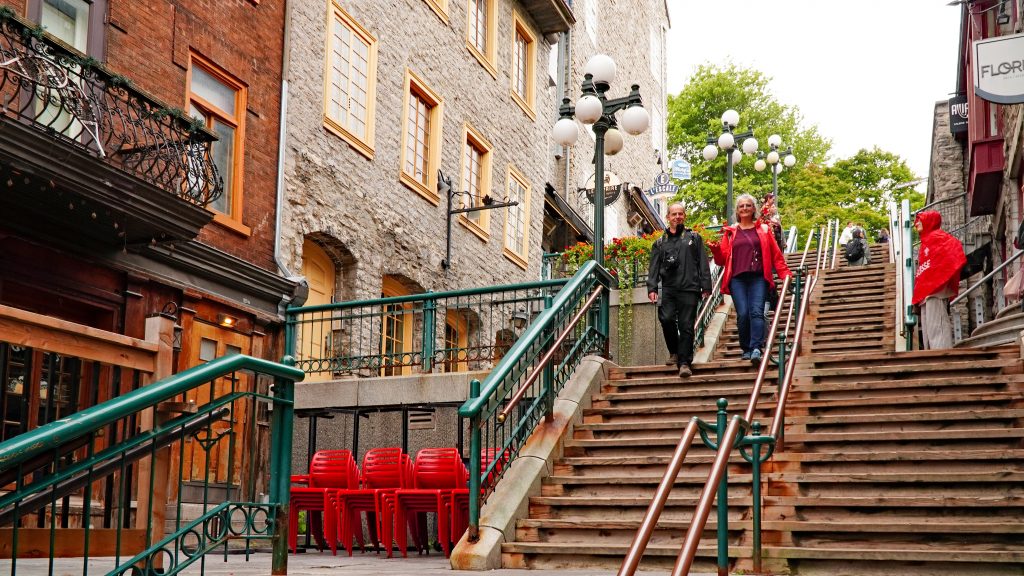
Today, the Breakneck Steps are a popular spot for tourists and a celebrated symbol of Québec City’s resilience. Walking up (or down) these steps is an experience in itself, offering fantastic views of Rue du Petit-Champlain, one of Canada’s oldest commercial streets, known for its cobblestones, street art, and seasonal decorations.

Walking down the Côte de la Montagne, you’ll see beautiful French or English style buildings that house pretty boutiques.
At the foot lay Rue du Petit-Champlain, straight out of a storybook — boutiques tucked into bright façades, windows glowing with artisan crafts, the smell of hot cider trailing through the air. Musicians played Québécois folk songs beneath twinkling lanterns, and the street pulsed with warmth and wonder.
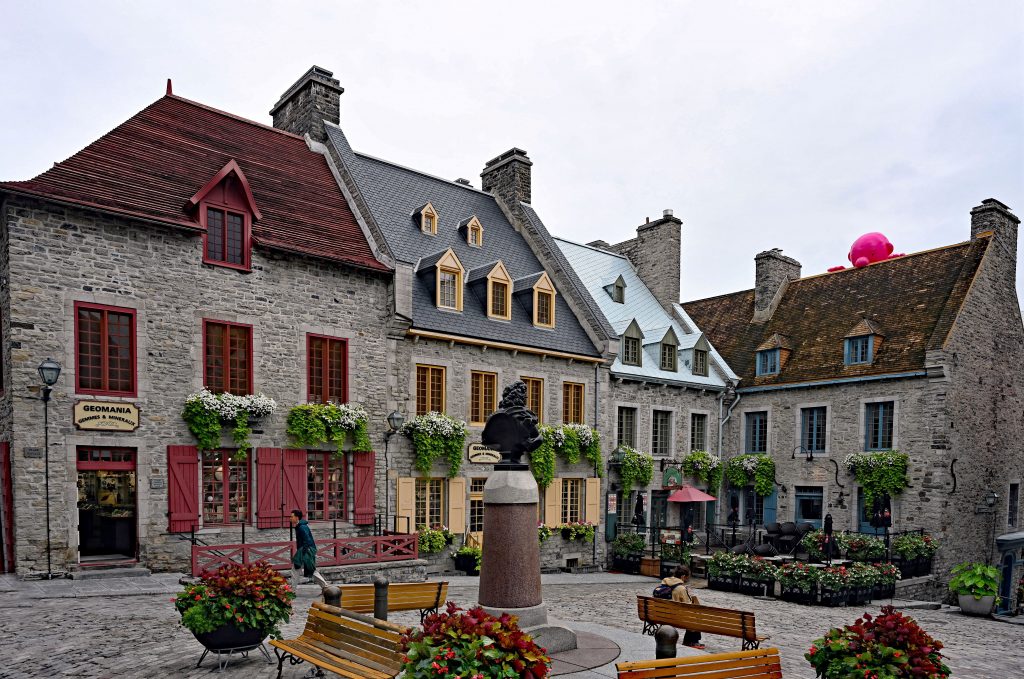
At the foot lay Rue du Petit-Champlain, straight out of a storybook — boutiques tucked into bright façades, windows glowing with artisan crafts, the smell of hot cider trailing through the air. Musicians played Québécois folk songs beneath twinkling lanterns, and the street pulsed with warmth and wonder.
🧺 14. Marché du Vieux-Port – Flavors of the Land
I wandered toward the Marché du Vieux-Port, where stalls overflowed with Québec’s bounty: fresh cheeses, forest mushrooms, tangy cranberries, maple syrup in every imaginable form. Farmers offered samples with pride, and I filled my bag with gifts from the land.
🍷 15. Bistro 1640 – Supper Among Shadows
As twilight painted the sky in lilac and gold, I returned to Bistro 1640, just beside Château Frontenac. Inside, candlelight flickered on stone walls as I tucked into venison stew with juniper and wild berries. Each bite tasted like a season, each sip of local wine like a toast to the past.
🌙 Final Reflections: Je Me Souviens
Québec City is a poem — written in stone, sung in the wind, and flavored with spice and snow. In a single day’s walk, I touched cathedrals, tasted centuries, and felt the pulse of a city that remembers. As the stars rose above the Château and the river whispered below, one phrase echoed softly in my heart:
“Je me souviens.”
I remember.
And now… so will you.
For more pictures, please play the video down.